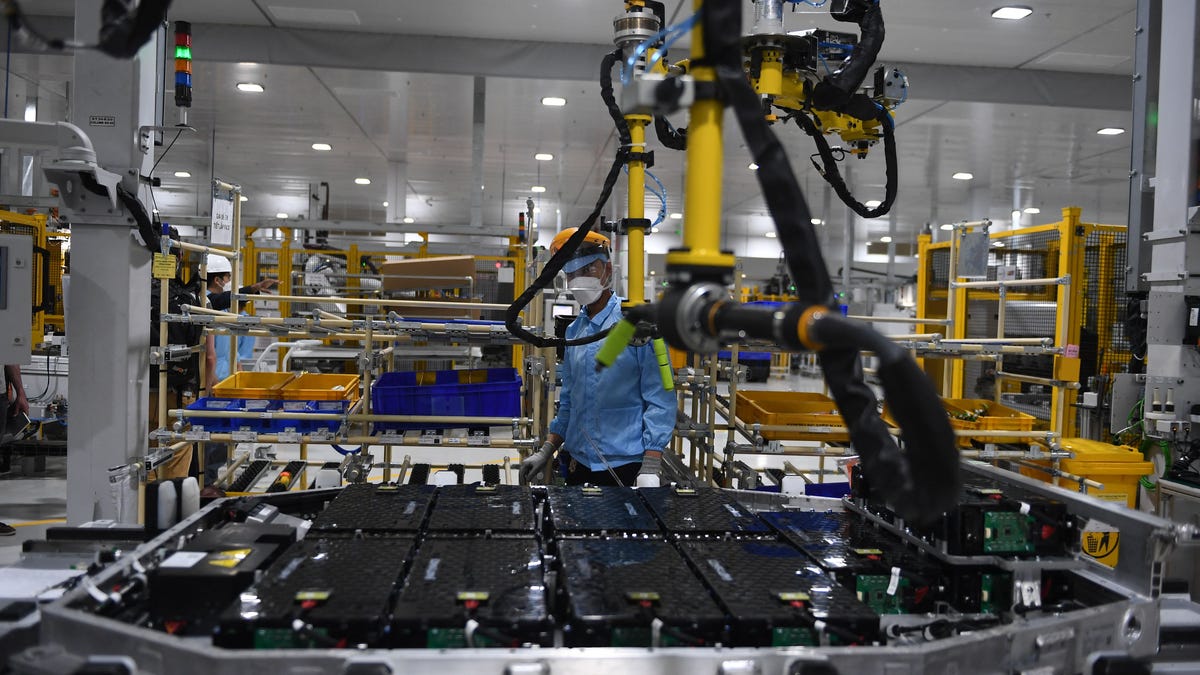The Environmental Price Of Clean Energy Is Still Too High: Report

A worker assembles an electric car battery inside the battery pack shop at the electric automobile plant of VinFast in Haiphong on April 7, 2022. Photo: Photo by Nhac NGUYEN / AFP (Getty Images)
In the face of that devastating IPCC report delivered in February, you might be considering taking some bare-minimum actions like buying an EV. This excellent deep dive published by Ars Technica Monday into what it really costs to go green is a stirring reminder that, while they produce less in terms of emissions, clean vehicles aren’t really all that clean.
It all comes down to mining and sourcing the rare metals used in building electric motors and batteries. The U.S. is currently racing to develop its domestic supply of lithium, cobalt and other rare earth metals but the mining of such metals is so dirty, so toxic, that it’s hard to imagine any American wanting it in their backyard as Shel Evergreen explains in their story “Elephant in the room”: Clean energy’s need for unsustainable minerals
In South America’s Atacama Desert, salt flats are dotted with shallow, turquoise-colored lithium brine pools. In the Democratic Republic of Congo, children chip at the ground for cobalt. In China, toxic chemicals leach neodymium from the earth.
This is the energy mineral rush. People around the world are scrambling, drilling, drying, and sifting to get at a range of metals needed for our energy transition. Renewable energy technologies are central to the fight against climate change, but they’re heavily reliant on minerals—naturally occurring, solid materials made from one or more elements. But extracting and refining them presents humanitarian, environmental, and logistical challenges.
Evergreen found that as we chase green energy, we create even more greenhouse gases in an infuriating feedback loop:
For example, producing these minerals is generally a more energy-intensive process than with other commodities. Production emissions for 1 metric ton of lithium carbonate, for example, are three times higher than that of steel, the IEA report says. Compounding this issue is that ore quality has been in steady decline for some minerals, which means more energy is needed to produce technology-grade materials. From 2001 to 2017, as the grade of copper ore declined, the electricity needed for refining increased by 32 percent, and fuel usage increased by 130 percent.
While the majority of mineral emissions are related to the rise of battery technology, wind power may also struggle to reduce its upstream impact. A recent study published in the journal Science of the Total Environment found that when green energy production grows by 1 percent, it leads to a 0.90 percent growth in greenhouse gas emissions. According to the study, from 2010-2020, the use of permanent magnets in renewable tech resulted in emissions amounting to 32 billion metric tons of carbon-equivalent emissions.
“We have to look at the problem of energy or green energy and solving of environmental problems from the perspective of systems engineering,” Kraslawski said. “Quite often, we can cause a lot of harm in terms of depletion of the resources, in terms of pollution, in terms of creating huge social problems,” he said.
Still, Raugei said the emissions problem is transient, as greenhouse gas emissions happen during the initial widespread deployment of these technologies, which is then followed by decades of carbon-free electricity generation.
G/O Media may get a commission
45% Off
Shark AI Robot Vacuum
Clean it up
Features incredibly methodical cleaning, has a deep clean feature for big days, is great at getting pet hair, and even comes with a self-emptying base.
The entire story is a fascinating look at all the ins and outs of green energy. It almost seems like, we aren’t going to be able to buy our way out of this. You can (and should) read the whole thing here.


